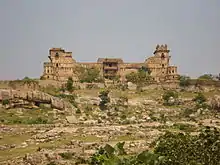Garh Kundar
Garh Kundar (also spelled Gadhkudhar) is a small village in the city of Tikamgarh, Niwari district of Madhya Pradesh. It has been named so after the splendid fort, or "Garh", of Kundar located here. From 925 to 1507 A.D, Garh Kundar fort witnessed many battles and bloodshed. Yashovarma Chandel (925–940 A.D.) built the fort after conquering south western Bundelkhand. In the battle between Prithviraj Chauhan and the Chandels in 1182 A.D fort commander. Shayaji Parmar lost and the fort came under Prithviraj Chauhan. Then Prithviraj Chauhan appointed Khetsingh Khangar as the ruler of this fort who founded the Khangar Dynasty afterwards.

The fort is built at the top of a hill and is five storyed in which two are underground and three are above it. The fort is built in such a way that it is visible from 5 km but as one keeps on coming near to it, the fort seems to be away from sight and the main road gets diverted to any other direction.
The history of the fort has been beautifully written by Vrindawanlal Verma in his book[1]
Khangar Dynasty
When Prithviraj Chauhan lost to Mohammad Ghori in 1192 A.D, then Khetsingh Khangar declared himself as the independent ruler. Under Khangar Dynasty, majority of the commanders were Parmars and Bundels who outside the royal court understood themselves higher than the ruler. The last ruler of Garh Kundar was King Hurmat Singh. The brother of Sohanpal Bundela was the commander of Mahoni state. Sohanpal and his twin brother had a grudge with each other for the control over Mahoni state.
Vishnu datt Pandey who was the financer of King Hurmat Singh was the friend of Sohanpal Bundela. When Sohanpal Bundela was made to leave Mahoni state by his brother, then he was helped by Vishnu Datt Pandey and by the orders of KIng Hurmat Singh, he took shelter as a state guest in Garh Kundar with Dheer Pradhan who was a Kayastha and a friend of Vishnu Datt Pandey.
KIng Hurmat Singh in exchange for helping Sohanpal Bundela put a condition of marrying his daughter Hemvati with his son Naagdev, but Sohanpal did not accept the condition.
Then Sohanpal after the advice of his son Sahjendra took help from Punyapal Parmar who was the ruler of Karera state and wrote the script of a game filled with bloodshed.
In 1288 A.D, (Vikram Samwat 1345), Sohanpal accepted the condition and the wedding arrangements were started. In the dinner, plenty of wine and meat was served only to Khangar Rajputs from Sohanpal, then the army of Punyapal Parmar came and killed all the Khangar Rajputs and their soldiers who were unarmed and high due to wine. In no time, the wedding dinner was converted to battleground and bloodshed occurred. The person who was given asylum, betrayed the state and the ruler. In this way, the Khangar Dyansty ended.
Bundela Dynasty
in 1288 A.D., the first Dynasty of Bundelas was established. Hemvati was wedded to Punyapal Panwar/Parmar. King Sohanpal was the first King of Bundelas who died in 1299 A.D.
After him, his son King Sahjendra Bundela ruled from 1299 to 1326 A.D.
In 1507 A.D., Bundela king Rudra Pratap Singh established Orchha as his new capital at the banks of Betwa River which is now famous for Shri Ram Mandir.
Origin of name
The name ‘Kundar’ is derived from ‘Kundarka’ (Kund + Arka, कुंड+अर्क). ‘Kund’ (कुंड) means ‘pond’ and Arka’ (अर्क) means ‘sun’. There was a pond in the village, It is said that the people used to get rid of their skin diseases after bathing in the pond or the ‘Arka-kund’. The remnants of the pond can still be seen near the temple of ‘Giddh vahini maa’ near the fort.
References
- Varmā, Vrndāvanlāl. (1954). Garh-kundār : Septamāvrtti Lakhanau. Gangā-granthāgār. OCLC 220917417.
